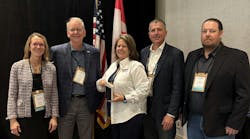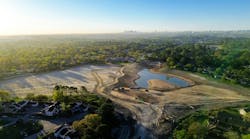Sunny Wescott delivers the 2024 StormCon keynote
Editor-in-chief of Stormwater Solutions Katie Johns started the keynote by welcoming all the attendees to StormCon 2024.
Johns announced the agenda for the event, including the announcement of the Top Projects later in the week.
Johns also talked about the state of the industry survey that is taking place on Stormwater Solutions.
The keynote speaker for the event is Sunny Wescott, who works for the Department of Homeland Security in the Cybersecurity and Infrastructure Security Agency.
Wescott started the keynote talking about how climate change is affecting the stormwater industry.
“All of our industry has been put in in the last 100 years,” said Wescott, “it has breaking points.”
She continued by talking about atmospheric pressure. Specifically, the highs and lows of pressures in the atmosphere, comparing it to a carousel. Wescott said that our infrastructure was built around small margins of pressure changes.
“What we’re saying is that we’re going to see all of our rain for the year in a few events vs. a whole season,” said Wescott.
Wescott said that if you’re under high pressure that you’ll experience more drying conditions. Changes in the upper atmosphere can have affects on ground conditions.
Wescott continued by focusing on “billion-dollar disasters,” stating that we’re already trending ahead of the previous year in terms of disasters that have taken place.
“Bigger storms are taking on an intensity rate that I haven’t seen,” said Wescott.
She then focused on national climate anomalies like temperature fluctuations.
Wescott talked about global climate conditions and how tornadoes have popped up in places around the world that haven’t recorded tornadoes before.
Wescott focused on the aging of our infrastructure. She talked about how most of our infrastructure was built in the past 100 years and that most of that infrastructure can have potential risks due to how the climate has changed over the past 100 years.
“Not everyone has planned for stormwater accordingly,” said Wescott, focusing on stormwater trends across the U.S.
“It’s hard to move somebody who hasn’t experienced these events just by showing them what has happened,” said Wescott.
Wescott then focused on how water is used across industries that rely on water to cool their production and tools, like manufacturing and computing.
Wescott talked about lesser-known problems of climate change such as checking the credentials of workers and responders without internet access due to storms, floods and hail, that can knock out infrastructure.
She talked about issues of people faking credentials to gain access to areas to steal things like generators.
Wescott talked about transportation impacts of climate change like hot spots that challenge the lift of planes and develop turbulence, making it harder to transport people and goods.
She spoke about how snowpack can have increased melt or fall as rain. Wescott stated that precipitation won’t stop altogether, but the delivery of the precipitation may change from usual snowpack to rain.
Wescott talked about fire weather and how tree lines have changed that creates an issue for more wildfires. A change in root systems and tree lines can make some areas more prone to fires.
“Groundwater and surface water play a role in the stability of our soils,” said Wescott. The weight of water can change due to more loose surface material caused by droughts and dust storms known as haboobs.
The variance in weight of water can change seismic activity.
Conversely, pumping groundwater out can result in regional subsidence.
Wescott stated that pumping aquifers to low levels can result in landslides and land collapse that can damage surrounding infrastructure.
Wescott talked about how public infrastructure and utilities should plan for severe storm events such as 100-year storms.
Severe storm events can lead to health issues for communities. Stagnant water can lead to bacteria growth and warmer waters can lead to algal blooms.
Wescott talked about energy sector loss due to increased extreme weather events.
“58% of outages were caused by severe weather,” said Wescott, “Diversifying our energy is one of the best things that we can do.”
Wescott concluded the keynote by talking about the effect of climate change on vegetation and how mining cryptocurrency can use massive amounts of water to cool computers.


